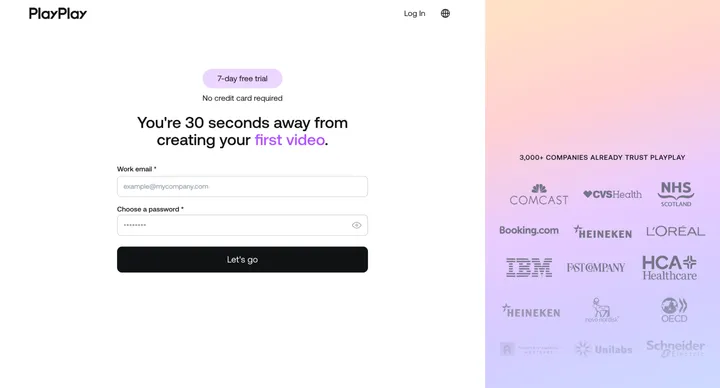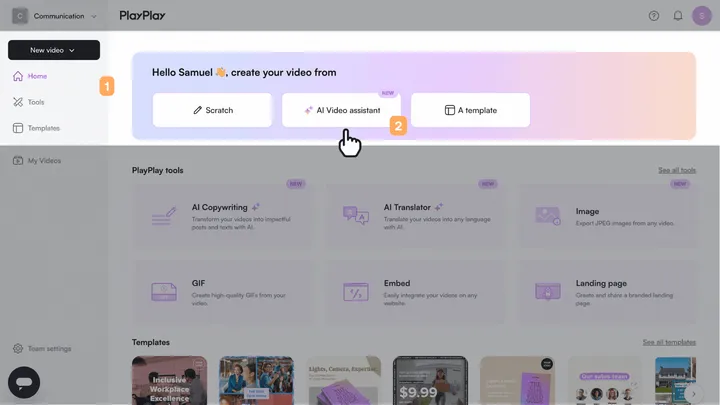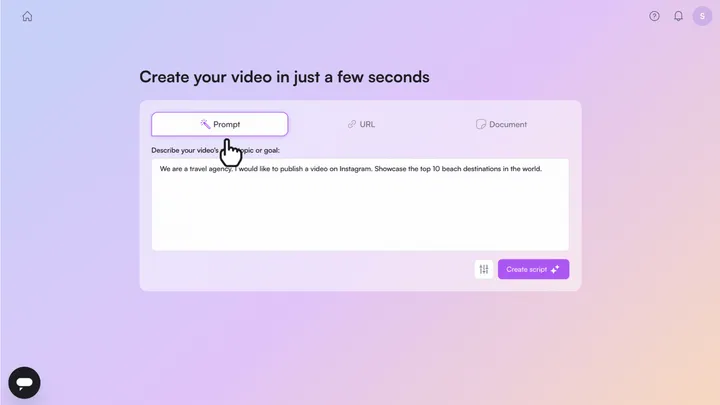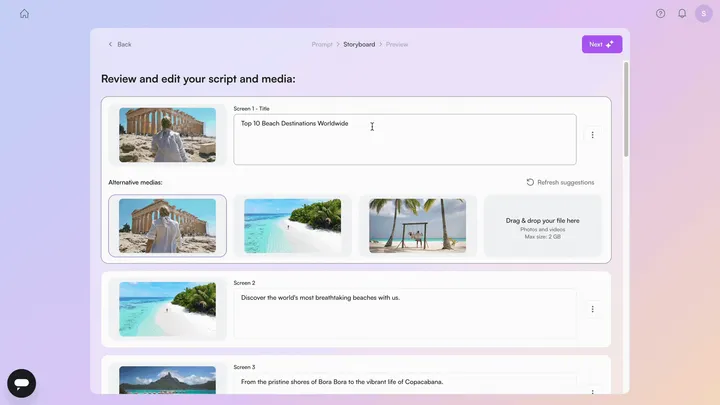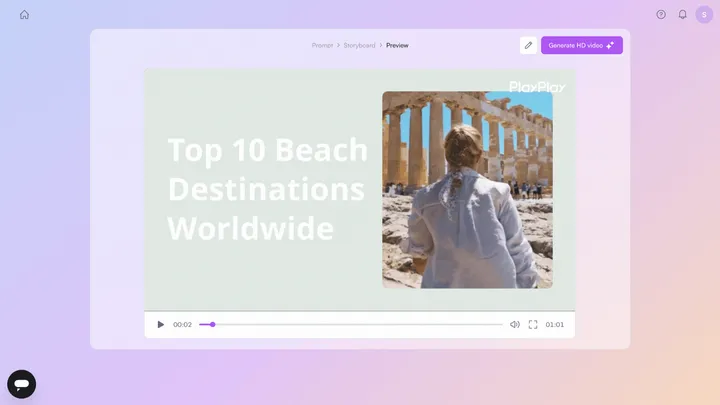What’s the secret when it comes to generating engagement on social media with your video content? Psychology is the key here. Knowing how a customer brain works and processes emotions is essential as it will help you create content that captivates your audience from start to finish.
This guide will tell you everything you need to know about using psychological hacks to bring your ideas to life and create engaging videos for your online marketing strategy. It includes 10 actionable tips and creative video presentation ideas to make that engagement rate skyrocket!
Here are the 10 best psychological hacks for creating engaging videos that your customers will love.
1. Spark their curiosity
As we mentioned earlier, your first goal is to capture your audience’s attention. Fast.
The best way to work on this is by taking advantage of the information gap theory of curiosity, which was developed by George Loewenstein in the early 90s. This theory claims that curiosity is a fairly simple process: it relies on the gap between what we know and what we want to know.
This means you should make sure that your video has a catchy title that sparks curiosity, and that its first 3 seconds are intriguing enough for any customer to keep watching.
Need inspiration? This Vodafone Ireland campaign relies entirely on the concept of curiosity, so that potential customers continue watching!
2. Speak to their emotions
Tapping into people’s thirst for knowledge is one way of viral video marketing which means to use emotions to your advantage, but there are many others to explore as well.
Several studies have been conducted to find out what specific emotions make any person want to watch and share a video—which means the video might go viral as a result.
According to the Harvard Business Reviews, the emotions that are most commonly found in viral content are usually positive, and include:
- Curiosity
- Amazement
- Interest
- Astonishment
- Uncertainty
- Admiration
Try to create your next video with one of these emotions in mind and see how it performs!
Take a look at how Duracell uses emotion to better connect with its audience:
3. Tell a story
Remember being read bedtime stories as a kid? People have been using telling stories as a way to communicate forever. After all, they make things easy to remember and take their listeners—or viewers—on a journey that triggers emotional responses too - engaging videos work in the same way.
In fact, according to a Berkeley study, character-driven stories cause oxytocin synthesis—oxytocin being the “love hormone”. And conveniently, every brand wants to be loved!
When it comes to the best video marketing strategies, stories help increase likeability and trust. And this, in turns, will make your audience more likely to make a purchasing decision.
To do so, you could focus on your company’s own story, involve your team members or, like AFLAC and its infamous duck, you could create a recurring character to embody your brand. Just let your creativity run free!
Here's another example by Google that does an excellent job at using video storytelling:
4. Be authentic
When watching a video, the last thing internet users want is a brand being obviously salesy and pushy with promotional content.
Video content is your chance to show the human side of your company to potential customers by generating emotions.
If people feel like you are authentic and transparent in your video, they are more likely to identify with your brand or product and read into it in the best way possible, which means that their chances of converting will be higher too.
Instead of making your video feel like a sales pitch, try using this format to show potential customers who your brand is and what it stands for.
By explaining the process that led to the creation of their product, mattress brand Casper made a genuine and authentic video to convince potential customers and eventually increase their sales:
5. Use social proof
Think about it… Would you be more likely to trust a recommendation from a person you know or an overly promotional video?
As a brand, your goal is to build trust among your target audience. To achieve this, it is sometimes better to let another person work on telling your story for you.
Here’s a quote we really like by Robert Cialdini, who wrote Influence: The Psychology of Persuasion:
“If you can get people who are similar to the person you’re trying to persuade to speak on your behalf, it’s a lot easier for you than if you have to try to hammer your message one more time into a reticent mind.”
When it comes to your videos, you could feature testimonials by happy customers who made a purchase or even work with people like influencers to help bring your story to life by spreading your message.
Here, Tesla relies on one of their best customer reviews to highlight their own authenticity:
6. Leverage FOMO
FOMO (“Fear Of Missing Out”) has become a classic internet speech in the social media age.
This acronym is used to describe what a person can feel when they have the sense that their friends are doing something more fun than what they are doing themselves in their life.
As a brand, you can use this feeling to your advantage: if your video is about a specific promotion or a new product, create a sense of urgency to purchase by implying that time is running out or that the product is likely to sell out quickly.
You could alternatively focus on what you feel, making your product or service special in your video.
Check out this example by Visit Pittsburgh for inspiration:
7. Use repetitions
Ever heard of the Baader-Meinhof phenomenon? Also called the “frequency illusion,” it describes the fact that once you encounter something new, you suddenly start to notice it everywhere.
In marketing, this frequency illusion is a cognitive habit that can easily be harnessed. It can be as simple as featuring your logo everywhere in your communication. To go one step further, you should also make sure that all video content reinforces ideas, topics, and concepts that your audience identifies with which will make them more likely to purchase your product or service.
What this means is that you should essentially be telling similar stories in different ways. This will allow you to create a frequency illusion within your audience which, in turn, will help you generate sales.
One of the best actionable tips here is to increase your sales involves creating videos that are tailored for social media and inspired by your current TV campaign.
8. Be relatable
We just mentioned making sure your audience identifies with your audience. Fun fact: research has shown that consumers perceive the same type of personality characteristics in brands as they do in other people.
This also means that they will identify with some brands more than others—just like you tend to like certain types of people more than others.
These attractions are emotion-based, and what better way to trigger emotional responses than with a video?
To make sure your video resonates with your target audience and generates engagement, it should express what the audience thinks or describe something they’ve experienced better than they could.
Some ways to make your brand more relatable include aligning with themes that are currently important in society, sharing your personal journey or that of your team members or taking a stance on a current issue.
Ben & Jerry’s are known for being a socially conscious brand and this video highlights this perfectly:
9. Use reverse psychology
Wait… what does reverse psychology mean again?
Let us break it down for you: to put it simply, reverse psychology means advocating for an idea or behavior that is the opposite of the one desired. The expected result of this approach is that the audience will feel like doing what the brand desires in return.
In marketing, this means avoiding telling people what to do and letting them make their own decision instead. The opposite of a sales pitch, if you will.
This can simply mean using a phrase like “you are free not to”, or you could opt for a more intricate idea.
A great example of a campaign that used reverse psychology in a subtle, yet incredibly efficient way is Dove’s Real Woman campaign.
Here, instead of focusing on the effectiveness of their beauty products, they decided to highlight the fact that women are beautiful as they are. A big, bold winning bet that will make customers more likely to purchase the products!
10. Be controversial
Warning: this last tip should only be used with caution!
"Controversy sells.", as they say. Or "all publicity is good publicity."
While we wouldn’t recommend creating a video with controversy as your only end goal, what we mean is that your brand should dare to stand up for its values. While controversial commercials don't get positive attention, they still manage to reach a wide audience of customers.
It has been shown that Millennials and Gen Z consumers like it when brands are vocal about social issues. As a company, you could take the decision to focus your next video campaign on a value that is important to you, even if it might seem risky at first.
A great, recent example of this would be Nike’s “Believe in Something” campaign video featuring ex-NFL quarterback Colin Kaepernick, who inspired a player protest movement by kneeling during the national anthem during games.
While it did spark a big debate, the campaign ended up generating over $43 million in free advertising for the brand, and its stock price even reached an all-time high after the ad was released.
Even though controversy can feel negative at times, this is proof that it can have positive consequences after all.
How to create engaging videos with PlayPlay
Now that you know everything about using psychological hacks to your advantage to create engaging videos, it’s time to create one!
Looking to level up your video marketing game? PlayPlay's incredible tool lets you create marketing videos that truly shine. Whether it's for LinkedIn, TikTok, or any platform, you'll captivate your audience and achieve outstanding results. Start crafting irresistible content now with PlayPlay!
Step 1: Sign up for a free PlayPlay account (for seven days)
Step 2: Click the video assistant button at the top of your dashboard
Step 3: Select “prompt” and enter the instructions for the film you want to make. Here’s an example prompt: We are a travel agency. I would like to publish a video on Instagram. Showcase the top 10 beach destinations in the world.
Step 4: Add context to your prompt by including your preferred tone, industry, and target audience.
Step 5: Click “Create Script” to view the video’s storyboard, screens, and content that the AI assistant proposed.
Step 6: Customize the AI video draft by adding or swapping images and brand elements and adjusting the screens.
Step 7: Click “Next” to generate a film preview. If you’re happy with the output, click “Generate HD Video” to see the final version of your video. You can also ask your team or colleagues for feedback beforehand.

Here are some more reasons you’ll love PlayPlay:
- Crop and resize: Use PlayPlay's multi-format resized tool to start editing for different channels and formats. In minutes, you can resize your video into vertical, horizontal, or square modes without affecting the quality of your output.
- Premium stock media library access: You also get access to our extensive library of royalty-free media — including images, video clips, and music — to make your adverts more engaging and appealing to your public.
- Brand elements: You can also customize your ads using your logo, colors, and other visual elements to help with recognition.
- AI video assistant: Accelerate your video creation process with our AI tool. Instantly generate first drafts from simple text prompts, eliminating the need to start from scratch. Get inspired with creative video ideas and tailor the draft to align with your brand’s needs. Edit and refine easily to produce a polished, high-quality final video. Or generate AI video for free.


